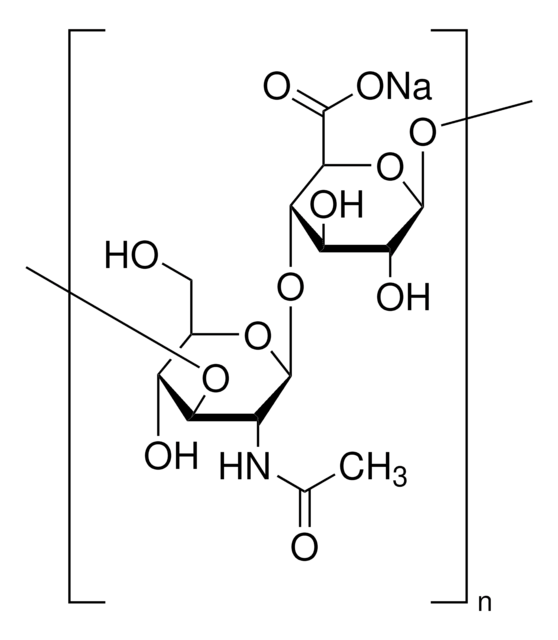SML2988
Tat-NR2B9c trifluoroacetate
≥95% (HPLC)
Sinónimos:
NA-1, trifluoroacetate salt, Tyr-Gly-Arg-Lys-Lys-Arg-Arg-Gln-Arg-Arg-Arg-Lys-Leu-Ser-Ser-Ile-Glu-Ser-Asp-Val, trifluoroacetate salt, YGRKKRRQRRR-KLSSIESDV, trifluoroacetate salt
Iniciar sesiónpara Ver la Fijación de precios por contrato y de la organización
About This Item
Fórmula empírica (notación de Hill):
C105H188N42O30 · xC2HF3O2
Número de CAS:
Peso molecular:
2518.88 (free base basis)
UNSPSC Code:
12352200
NACRES:
NA.77
Productos recomendados
Biochem/physiol Actions
Tat-NR2B9c (NA-1) is a 20-mer peptide composed of a membrane-permeant HIV-1 Tat protein transduction domain sequence (a.a. 47-57) N-terminal to the NMDA receptor (NMDAR) GluN2B carboxyl tail sequence KLSSIESDV that blocks intracellular NMDAR-PSD-95 interaction-induced neurotoxic signaling without affecting NMDAR-mediated synaptic activity or calcium influx. NA-1 protects cultured cortical neurons from NMDA excitotoxicity (50 nM; 20/40/100 μM NMDA) and reduces focal ischemic brain damage in rats in vivo (3 μmol/kg iv. bolus 1 hr post MCAO onset).
Storage Class
11 - Combustible Solids
wgk_germany
WGK 3
flash_point_f
Not applicable
flash_point_c
Not applicable
Certificados de análisis (COA)
Busque Certificados de análisis (COA) introduciendo el número de lote del producto. Los números de lote se encuentran en la etiqueta del producto después de las palabras «Lot» o «Batch»
¿Ya tiene este producto?
Encuentre la documentación para los productos que ha comprado recientemente en la Biblioteca de documentos.
Luka R Srejic et al.
Journal of cerebral blood flow and metabolism : official journal of the International Society of Cerebral Blood Flow and Metabolism, 33(12), 1937-1943 (2013-09-12)
Since the most significant ischemic sequelae occur within hours of stroke, it is necessary to understand how neuronal function changes during this time. While histologic and behavioral models show the extent of stroke-related damage, only in vivo recordings can illustrate
Karen Tse et al.
Journal of neuroscience research, 97(11), 1378-1392 (2019-05-16)
Antiepileptogenic agents that prevent the development of epilepsy following a brain insult remain the holy grail of epilepsy therapeutics. We have employed a label-free proteomic approach that allows quantification of large numbers of brain-expressed proteins in a single analysis in
Gabriella MacDougall et al.
Journal of molecular neuroscience : MN, 61(2), 235-246 (2016-11-21)
We have previously reported that cationic poly-arginine and arginine-rich cell-penetrating peptides display high-level neuroprotection and reduce calcium influx following in vitro excitotoxicity, as well as reduce brain injury in animal stroke models. Using the neuroprotective peptides poly-arginine R12 (R12) and
Zhifeng Wang et al.
Journal of cerebral blood flow and metabolism : official journal of the International Society of Cerebral Blood Flow and Metabolism, 39(8), 1588-1601 (2018-03-08)
Postsynaptic density protein-95 (PSD95) plays important roles in the formation, differentiation, remodeling, and maturation of neuronal synapses. This study is to estimate the potential role of PSD95 in cognitive dysfunction and synaptic injury following intracerebral hemorrhage (ICH). The interaction between
Yanting Chen et al.
Journal of cerebral blood flow and metabolism : official journal of the International Society of Cerebral Blood Flow and Metabolism, 35(5), 739-742 (2015-02-12)
The Tat-NR2B9c peptide has shown clinical efficacy as a neuroprotective agent in acute stroke. Tat-NR2B9c is designed to prevent nitric oxide (NO) production by preventing postsynaptic density protein 95 (PSD-95) binding to N-methyl-D-aspartate (NMDA) receptors and neuronal nitric oxide synthase;
Nuestro equipo de científicos tiene experiencia en todas las áreas de investigación: Ciencias de la vida, Ciencia de los materiales, Síntesis química, Cromatografía, Analítica y muchas otras.
Póngase en contacto con el Servicio técnico








